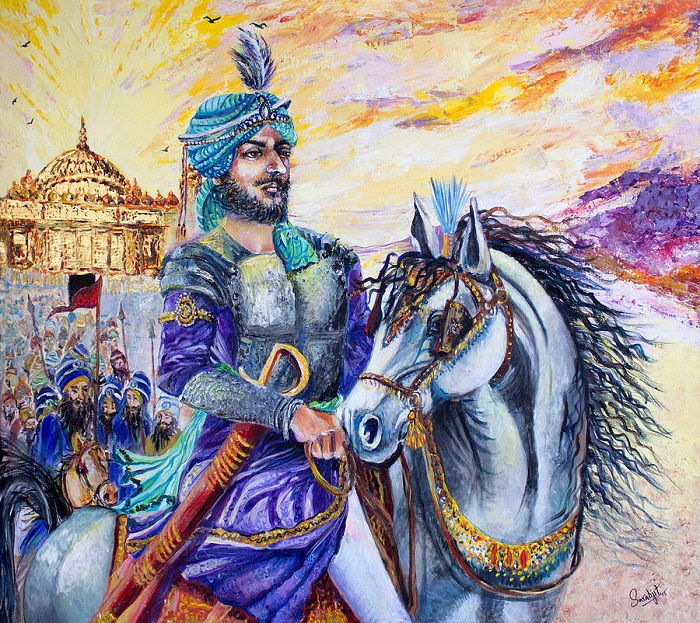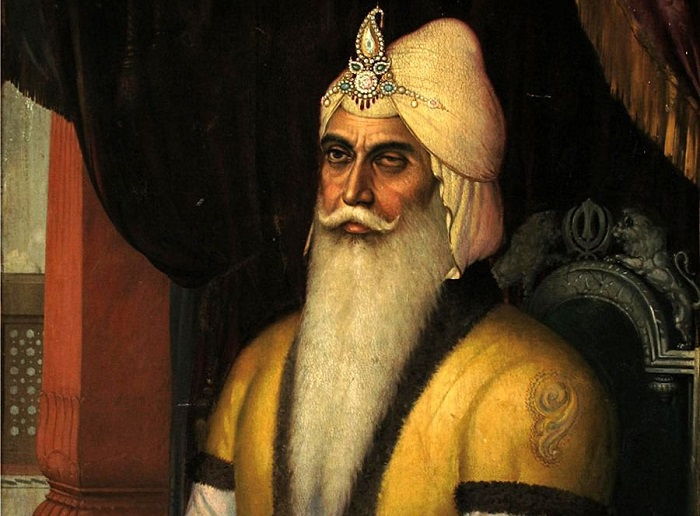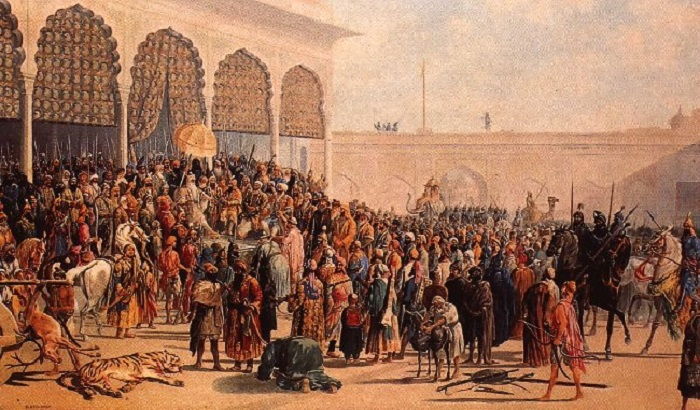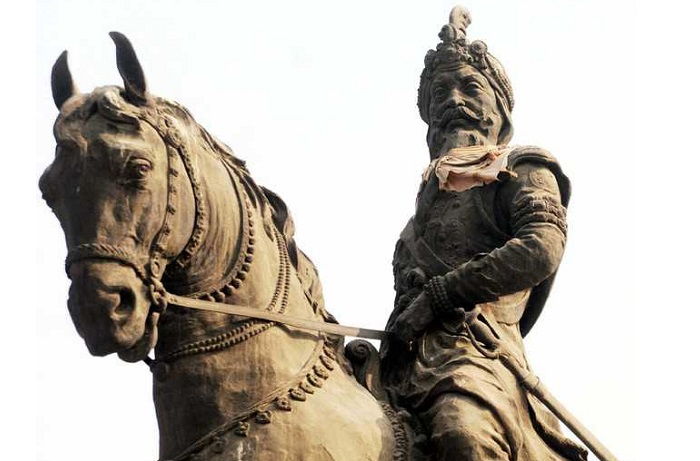Fast Facts
Date of Birth: November 13, 1780
Place of Birth: Gujranwala, Punjab region, Sukerchakia Misl of the Sikh Confederacy (Presently in Pakistan)
Death: June 27, 1839
Place of Death: Lahore, Punjab region, Sikh Empire (Presently in Pakistan)
Reign as Chief of Sukerchakia Misl: April 1792 – April 11, 1801
Reign as King of the Sikh Empire: April 12, 1801 – June 27, 1839
Maharaja Ranjit Singh was the king of the Sikh Empire, which was formed under his leadership and eventually emerged as major power in the Indian subcontinent. Popularly known as Sher-e-Punjab or Lion of Punjab, this gallant king became Chief of Sukerchakia Misl following his father’s death. He fought several wars to expel the Afghans. Formation of Sikh Empire started after he captured Lahore, which was followed by ouster of Afghans from Punjab after the Afghan-Sikh Wars and eventual merger of separate Sikh Misls into a unified political state. At age 21, Ranjit Singh proclaimed himself “Maharaja of Punjab”. He established a secular empire based in Punjab and expanded it till his death in 1839. His reign witnessed modernisation of army and other leading-edge efforts apart from a renaissance in Sikh art and culture. Although his son Kharak Singh succeeded him to the throne, the internal divisions and political mismanagement within the empire weakened it leading to its collapse in 1849 following defeat in the Anglo-Sikh wars.

Image Credit : https://pixels.com/featured/maharaja-ranjit-singh-sarabjit-singh.html
Childhood & Early Life
He was born as Buddh Singh, named an ancestor, on November 13, 1780, to Maha Singh Sukerchakia and Raj Kaur from the Sandhawalia Jat tribe. Among the Sikh misls or sovereign states of the Sikh Confederacy that rose in the Punjab region of Indian subcontinent in the 18th century, the Sukerchakia misl was the most powerful. After Maha Singh’s army defeated Muslim Chatha chieftain Pir Muhammad, he changed his son’s name from Buddh to Ranjit, meaning a victor in battle.
During his infancy, Ranjit Singh suffered from smallpox which left him with a pockmarked face and also affected his left eye resulting in loss of its sight. As a child, he was never schooled and only knew how to read and write the Gurmukhi alphabet but received training in martial arts, horse riding and musketry. He was just 10 years old when he fought his first battle while accompanying his father. He inherited the Sukkarchakkia misl estates of his father at age 12 after the latter’s death in April 1792 and became Chief of Sukerchakia Misl. He was thereafter brought up by his mother along with Lakhpat Rai, both of whom managed the estates. He lost both of them at age 18 following which he received help from his mother-in-law Rani Sada Kaur from his first marriage with Mehtab Kaur.
A man of short stature, Ranjit Singh took to drinking as a teenager. He however refrained from smoking and eating beef, and also made it a rule that those who will work as officials in his court, irrespective of the religion they belong to, should abstain from such habits.
Foundations of the Sikh Empire, Early Conquests of Ranjit Singh
Following death of Mughal emperor Aurangzeb way back in 1707, the Mughal Empire witnessed a steady downfall. Dwindling of Mughal power was precipitated by expeditions against them as also the Afghans in the west by Dal Khalsa, a rearrangement of the Sikh warrior community called Khalsa initiated by Guru Gobind Singh, the last living Guru of Sikhism. Eventually the Sikh army strengthened and split into a number of confederacies or semi-independent misls. Different areas and cities were controlled by each of these component armies. Before Ranjit Singh rose to fame there were fourteen small warring regions in the north-western areas of Indian subcontinent that presently constitute Pakistan and some areas of North India. Among these twelve were Sikh misls (confederacies), one near Lahore was a Muslim confederacy named Kasur and one in the southeast was led by George Thomas, an Englishman. By this time the Sikh misls warred with each other over several issues including local priorities and revenue collection but they would generally unite to face any external invasion. Ranjit Singh hailed from the powerful Sukerchakia misl, and had alliance with two other powerful Sikh misls, the Kanhayas and the Nakkais through his marriage.
He rose to fame at age 17. This happened in 1797 when a battle occurred in the territory within the misl controlled by him where the invading army of Afghan Muslim ruler Shah Zaman, of the Ahmad Shah Abdali dynasty made effort to annex Punjab region into Shah Zaman’s control. Ranjit Singh applied his regional awareness and warrior skills and thrived in resisting the Afghan invaders thus ensuring victory of the Sikhs. He furthered his fame when Shah Zaman sent another army in 1798. The astute Ranjit Singh did not confront the Afghans initially and let them enter Lahore following which his army surrounded them, cut off their supplies including food so as to weaken them, most of whom receded to Afghanistan.

Image Credit : https://www.thefamouspeople.com/profiles/ranjit-singh-6233.php
The first major victory of Ranjit Singh happened in 1799 when he attacked the region under control of the Bhangi Sikhs that were centred around Lahore. His army was backed by another army led by Rani Sada Kaur. While the rulers fled, the Hindus and Sufi Muslims of Lahore accepted him as the ruler. The control of Jammu region was also ceded by its ruler to him in 1800.
Proclamation as Maharaja of Punjab & Expansion of Empire
He proclaimed himself “Maharaja of Punjab” and started reigning as Emperor of the Sikh Empire from April 12, 1801. He gave the name “Sarkar Khalsa” to his rule and called his court “Darbar Khalsa”. He directed issuer of new coins in the name of Guru Nanak called the “NanakShahi”. He took Amritsar from the Bhangi Sikh misl in 1802. He signed a treaty with East India Company officials agreeing not to expand south of Sutlej River while the latter assented that militarily they would not move beyond the Sutlej River to the Sikh Empire. The years that followed saw Ranjit Singh expanding the Sikh empire. These included capturing Kasur in 1807 defeating Afghan chief Qutb-ud-Din; taking Multan in 1818 that led him to add the whole Bari Doab to his empire and ending Afghan influence in the Punjab; and annexing Srinagar and Kashmir in 1819 defeating Afghan Sunni Muslim rulers. He overpowered a large army of Yusufzai, a tribe of Pashtun people, north of the Kabul River in 1823 and defeated an army of 25,000 Khattak and Yasufzai tribesmen in 1834. The Battle of Jamrud was fought between the Emirate of Afghanistan under Emir Dost Muhammad Khan and the Sikh Empire under Ranjit Singh on April 30, 1837. He marched into Kabul with his troops in 1838 to participate in the victory parade with the British following restoration of Shah Shoja to the Afghan throne. The major towns that came under his reign include Lahore, Multan, Amritsar, Rawalpindi, Peshawar, Attock, Gujrat and Jammu.
Governance, Policies, Modernisation & Reforms under His Reign
Ranjit Singh established a secular Sikh rule where his army and government included people of different race and religion. For instance he had a Dogra prime minister, Dhian Singh; a Brahmin finance minister Dina Nath; and a Muslim foreign minister, Fakir Azizuddin; while many Afghan and Punjabi Muslims fought battle under his rule against the Afghan forces of Nadir Shah and Azim Khan. He also had Muslim artillery commanders like Mian Ghausa. His army also had French, Spanish, Russian, Prussian and Polish officials. Although he maintained friendly relation with the British he did not induct any British men under his rule excepting in an instance where he hired British officer Foulkes in 1835.

Image Credit : http://www.sikh-history.com/sikhhist/warriors/ranjit10.html
His reformatory measures were concentrated more on enhancing his military and ensuring security of his empire. He altered and improved his army’s training and organisation and bettered war methods and equipment. He adopted a military system blending best of both old and new concepts and reinforced the artillery and infantry. In pursuit of making Panjab self-reliant, he initiated manufacture of all weapons, munitions and other equipment necessary for his army. During the 1800s, government led by Ranjit Singh made infrastructure investment and then set up arm and gunpowder factories, cannon foundries and raw materials mines. He however did not pay much heed to reform the Jagirs-based taxation system to end abuse nor did he initiate uniform laws or made effort in enhancing internal trade or to increase power of peasants and merchants. No significant investments were made to better the productivity of land and roads. He however reopened trade routes that paved way for increased independence in commerce while his reign witnessed less violence compared to the Mughal-Sikh wars era.
A devoted Sikh himself, Ranjit Singh revered all religions and made his policies on that basis. No forced religious conversion took place during his reign. He built two sacred Gurdwara to commemorate the birthplace and place of assassination of Guru Gobind Singh, namely the Takht Sri Patna Sahib (presently located in Patna, Bihar, India) and the Takht Sri Hazur Sahib (presently located in Nanded, Maharashtra, India) respectively. He also restored Sri Harmandir Sahib, now famous as the Golden Temple and considered the most holy Gurdwara and significant pilgrimage site of Sikhism. Ranjit Singh who used to offer thanks and celebrate his victories in this Gurdwara, rebuilt it in 1809 with marble and copper. The sanctum of the Gurdwara was overlaid by him with gold foil in 1830. He also visited temples, Sufi mosques and other holy places and respected Hindu sentiments by prohibiting slaughter of cows. No places of worship irrespective of religion were demolished by the Sikhs under his rule, however some of the Muslim mosques were converted for different purposes. These include desecration of the Badshahi Mosque in Lahore that was used as a garrison by the Sikh Empire and conversion of the Moti Masjid (Pearl Mosque) of Lahore into a Sikh temple called Moti Mandir. The later was also used by him later for the state treasury. He willed the Koh-i-Noor diamond that he gained from Shuja Shah Durrani of Afghanistan to the Hindu Jagannath Temple in Puri (presently in Odisha, India) that was then administered by the East India Company.
Personal Life, Death of Ranjit Singh, Decline of Sikh Empire & Legacy
According to sources he had twenty wives and many mistresses. He received punishment from the Akal Takht for some of his non-Sikh actions which included marrying a Muslim nautch girl Moran Sarkar in 1802. He had eight sons but acknowledged only Kharak Singh from his second wife Datar Kaur and Duleep Singh from his youngest wife Jind Kaur as his biological sons.

Image Credit : https://www.tribuneindia.com/news/amritsar/maharaja-ranjit-singh-s-statue-suffers-neglect/189050.html
He suffered from several health issues during the 1830s which included a stroke. He breathed his last while sleeping on June 27, 1839. Four wives and seven concubines of Ranjit Singh committed the funeral custom of Sati by immolating themselves on his pyre on their own will. The Samadhi of Ranjit Singh was built in that place (presently in Lahore, Pakistan) which houses his funerary urns. His son Kharak Singh succeeded him to the throne.
Following his death, the Sikh Empire witnessed internal divisions and political mismanagement which many attribute to Ranjit Singh’s failure to reform the Jagirs-based taxation system and economy which to some extent paved way for succession power struggle, divisions within the Sikh community, major assassinations and coups. Such circumstances weakened the Sikh Empire severely and this situation was taken advantage of by the British East India Company who initiated the Anglo-Sikh Wars. The Sikh Empire ultimately fell in 1849 and dissolved into different princely states and the British province of Punjab following the Second Anglo-Sikh War.
A 22 feet tall bronze statue of the Maharaja was erected in the Parliament of India on August 20, 2003. Some objects like arms and armour, jewellery, coins, manuscripts and paintings related to him are displayed in a museum at Ram Bagh in Amritsar.


